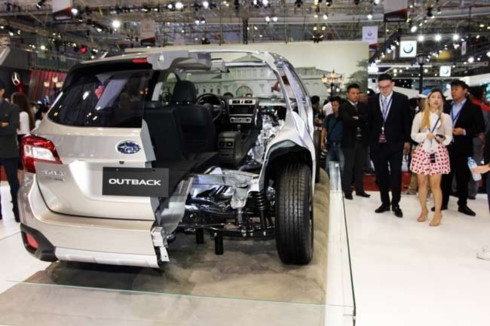While billions of dollars is spent annually importing auto parts for assembly at home, Vietnam exports a roughly equivalent value of spare parts for automobiles, motorbikes and motor vehicles every year.

However, export in this field is just a playground of foreign businesses. Domestic enterprises are basically still outsiders.
In the first half of 2018, Toyota Vietnam exported over US$34 million worth of auto parts, up 13% year-on-year. Last year, the company earned US$64 million from export, a rise of 5% from 2016. That is also the largest export value since this Japanese joint venture put its center for export of automotive parts in Vietnam into operation in 2004.
Currently, Toyota Vietnam’s major export items are antenna, exhaust valve, accelerator and floor plug. With Thailand, Indonesia, the Philippines, Malaysia, India, Argentina, South Africa, and Venezuela as its main markets, this automaker has recorded a total turnover of more than US$500 million, greatly contributing to the total growth in export of this commodity group.
The export value of auto parts is now nearly US$1 billion higher than their import value, said Nguyen Thi Xuan Thuy from the Institute for Industry Policy and Strategy under the Ministry of Industry and Trade. Some auto parts shipped out from Vietnam have relatively high technology, such as ignition wire set, gearbox spare parts, and airbag, etc. In other words, there are manufacturers of high-quality automotive components in Vietnam, who have joined the global supply chain, and do not just make the simple products.
Exports of vehicles and spare parts brought in nearly US$7 billion in 2017, up 15.4% year-on-year, as per statistics from the General Department of Customs. In the first six months of 2018, US$4.03 billion worth of this commodity group was shipped overseas, an increase of 19.4% over the same period last year. In recent years, this group of products has generated a larger export turnover than some other groups which were once Vietnam’s key exports, occupying the eighth slot among the commodity groups with the highest export values at present.
Vehicles and spare parts from Vietnam are even bought by those nations with an advanced auto industry such as Japan, that paid US$1.17 billion in H1 (up 15.1% year-on-year), and the U.S., that spent US$625 million (up 27.4%). Some other markets like Thailand, Germany, China, and South Korea have also boosted import from Vietnam.
Although completely built-up vehicles are included in the statistics, observers believe the main contributor to the export of this commodity group is auto parts. It is because locally-assembled cars cost 20% more than finished units made in regional countries like Thailand and Indonesia. Their export is often infeasible.
As for motorcycles and their spare parts, they are being exported by Honda Vietnam and Piaggio Vietnam. However, even Honda as the largest exporter of such items brought in only US$330 million last year.
Who is the supplier?
Nguyen Thi Xuan Thuy attributed the positive results the auto parts industry of Vietnam has obtained (production technology, export turnover) to the foreign side. Some foreign-invested enterprises (FIEs) have chosen Vietnam as a production site for global export.
Corporations from Japan and Taiwan have been present in Vietnam since the early stage, including MTEX, FAPV, Nissei, Nidec Tosok, Furukawa, Okaya, Nagata, Sanyo Seisakusho, Pronics, and Cobal Yamada, to name just a few. They have been supplying components and spare parts for the world’s leading automakers, but not for the domestic market.
Later, Vietnam has attracted auto part suppliers from other countries such as Germany, the Republic of Korea, and Thailand. For example, the Bosch Powertrain Solutions factory in Dong Nai, after a decade of operations, has become a manufacturer of CVT pushbelt for the automotive sector, the largest in the global system of Bosch, serving automobile manufacturers in Asia-Pacific and North America.
Many investors said they would pour more capital and expand their production as Vietnam is now considered one of the leading investment destinations in the world. Nidec Corporation (Japan) said it would step up its investment here, but declined to provide details. Meanwhile, late last year, Bosch made known its plan to spend an extra sum of 58 million euros (or US$67 million) to raise the total investment in its factory in Dong Nai to 321 million euros (US$372 million) by the end of this year.
While expanding production for export, foreign suppliers seem to have shown interest in Vietnam’s auto market as they see the Government’s determination to develop this sector.
Suttisak Wilanan, deputy director of Reed Tradex, an organizer of industrial exhibition events from Thailand, is optimistic about the strong recovery of the domestic auto industry with VinFast’s investment projects, and recently the inauguration of Thaco’s largest and most modern Mazda plant in Southeast Asia. Moreover, Toyota is seeking the permission for additional investment to double the production capacity of its plant in Vinh Phuc to 90,000 units a year by 2023. With a strategic position at the heart of the ASEAN region, where many major seaports are operational, Vietnam will have many opportunities for cooperation with Thai and Indonesian carmakers to develop her auto parts industry, said Suttisak Wilanan.
Recently, Pyeong Hwa Automotive (the Republic of Korea) has been granted an investment certificate to build an auto parts factory in Dinh Vu Economic Zone (Haiphong). This US$16.7-million project is expected to come on stream in September 2019. Pyeong Hwa’s goal is to provide auto parts for Southeast Asia.
Some large domestic firms have also expressed their determination not to miss the chance. Thaco—with five plants for assembly of trucks, buses, and sedans such as Kia, Mazda and Peugeot—has already developed 15 facilities for manufacturing of auto parts, serving its automobile assembly. The company brought in millions of dollars from exports last year. This year, Thaco aims to export US$6.4 million worth of auto parts. Along with Truong Hai, new player VinFast is expected to create a new motivation for the development of the industry for automobiles and spare parts in Vietnam.
Saigon Times